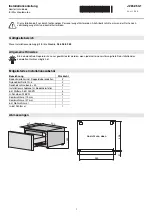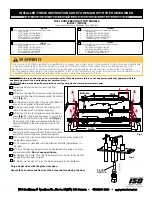
14
6.
Make sure that the seat belt in not twisted, then buckle in place.
7.
Make sure the restraint system is flat against the vehicle seat’s
bottom and back. Use your hands to apply firm pressure to the
restraint, pushing it into the vehicle backrest—or better yet, place
your knee on the restraint and push down with all your weight—-
while pulling on the vehicle seat belt and removing all slack from it.
8.
Check to make sure the tether strap is not twisted and then tighten
to secure the upper portion of the restraint. If the vehicle does not
have a top tether anchor point, it will be necessary to use a bolt-in
anchor mounting bracket.
See Installation Without LATCH Top
Tether Anchors
.
9.
DO NOT USE
this restraint without the tether strap properly
installed.
10.
Verify that the vehicle seat belt is tight and that the Positioning
Restraint System is secure. When properly installed, the restraint
will not move more that 1” (25mm) from side to side and or front to
back. If the restraint is not secure, repeat steps 4 — 7.
Aircraft Installation
1.
Place the Positioning Restraint System in a forward facing position
on the vehicle seat.
If the front edge of the restraint extends
more that 1” (25mm) beyond the front edge of the seat, then
the vehicle seat is too shallow to properly support the restraint
system. If this is the case, do not install.
2.
Pull the lap belt out completely, then route the belt between the
back of the restraint and the metal tubes which are located along
the sides of the Positioning Restraint System.
3.
Make sure that the seat belt in not twisted, then buckle in place.
4.
Make sure the restraint system is flat against the vehicle seat’s
bottom and back. Use your hands to apply firm pressure to the
restraint, pushing it into the vehicle backrest—or better yet, place
your knee on the restraint and push down with all your weight—-
while pulling on the vehicle seat belt and removing all slack from it.
5.
Verify that the vehicle seat belt is tight and that the Positioning
Restraint System is secure. When properly installed, the restraint
will not move more that 1” (25mm) from side to side and or front to
back.
15
Installing the Tether Strap
LATCH Vehicle Installation
The TheraPedic Positioning Restraint System includes a top anchorage
strap, known as a tether. The tether is engineered to make attachment
to the upper anchor points of the LATCH system easier.
LATCH (
L
ower
A
nchor and
T
ethers for
CH
ildren) anchors have been
required on all US passenger vehicles since 2002.
IMPORTANT:
Read these instructions completely and check your
vehicle owner’s manual prior to installation to determine the proper
attachment method and locations to position this Positioning Restraint
System.
IMPORTANT SAFETY WARNINGS:
The tether must be used when installing the Positioning Restraint
System. Use of the tether improves safety and reduces the risk of
injury.
The tether must only be attached to tether anchor points designated
as tether anchor points by the vehicle
manufacturer
.
This icon is used by vehicle
manufacturers to identify the LATCH
anchors. Use of other locations is not
approved or permitted.
Without tether strap
with
































